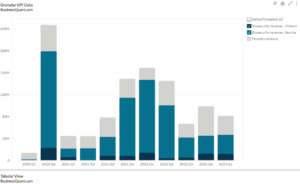
Microsoft Azure’s Revenue (2015-2023)
Exclusive Data
You need the Pro Plan to access KPI data
- Full access to the platform
- KPI data & segment financials on US stocks
- Financial data on thousands of stocks
- Download data in xlsx and csv formats
Pro Plan
$49 per month*
60% discount ends in:
.
About
More information
Subscribe to Pro or Enterprise plans to unlock this feature.
Contact the Analyst
Subscribe to Pro or Enterprise plans to unlock this feature.
Become a smarter investor today.
Access KPIs & Segment Financials on US stocks
This statistic highlights Microsoft Azure’s Revenue, reported on annual basis from 2015 onwards.
Microsoft Azure is Microsoft’s public cloud computing platform. It was formerly known as Window’s Azure. It provides various types of cloud services like computing, analytics, networking, and storage. Azure is primarily used for commercial purposes. Azure offers 4 different forms of cloud computing:
- Infrastructure as service (IaaS)
- Platform as service (PaaS)
- Software as service (SaaS)
- Server less
Microsoft uses a pay as you go approach to charge its customers. It sends a bill to its customers at the end of every month based on the resources they have utilized in that month. Microsoft offers different plans for customer support to its users. The plans vary in terms of scope and costs. Basic support is available to all Azure accounts, but they charge a fee for the other support offerings. Developer support costs $29 per month, Standard support costs $100 per month and Professional Direct support costs $1000 per month. Microsoft does not disclose the costs for Premier support. Azure is primarily used for hosting databases, backup and disaster recovery, data retention, integration, etc.
Microsoft Azures’s revenue has constantly been growing from $880 million in 2015 to $13 billion by 2019. Revenue from Microsoft Azure grew 72% from 2018 from $7.56 billion to $13 billion. Azure contributed to almost 10.5% of Microsoft’s total revenue in 2019. It has also been noted that the US defense chose Azure in its tactical operations. The last quarter earnings of 2019 grew by 64%. This may seem like a large number, but it was a part of the downtrend that Microsoft was experiencing in 2019. The growth rates for 2019 were as follows:
- Q1-76%
- Q2-76%
- Q3-72%
- Q4-64%
This is not too much of a concern since it is still moving at a healthy growth rate.
Microsoft stands at number two in terms of cloud infrastructure just behind AWS, but its well ahead of the other players. Their revenues are growing faster than the average market growth. They have also been gaining market share in recent years from 9% in 2016 to about 16% as of 2019.
Azure revenue seems to be picking up with revenues showing a growth of 62% by the start of 2020. The cloud market seems to be growing at a rapid rate with more and more companies looking to move most of their workload to public cloud vendors like Microsoft, Amazon, and Google. There is a lot of opportunity ahead for Microsoft and all of its rivals, and while Microsoft’s Azure earnings growth may be slowing down, there is still plenty of room for significant revenue increase in the foreseeable future.
Did you like Microsoft Azure’s Revenue statistic? Get access to such granular datasets by registering for free.
More data on US Stocks

Our Plans
Always know what you’ll pay. No hidden costs or surprises.
- Annual
- Monthly
60% discount till April 30
Pro
For serious investing
-
Company KPI data Access segment financials, non-GAAP metrics and KPI data from presentations and filings. Examples include financials by segment / region / product category, AT&T's broadband subscriber trends, Tesla's deliveries by model and lots more.
-
Stock research tools Features include : stock screener, stock comparison, industry financials, stock warnings, advanced charting tools, timeseries tables, scatter charts, financial statements, stock reports, SEC filings, stock ratings, institutional and insider ownership data. There are 200+ financial items and ratios on thousands of US stocks.
-
Industry data & tools Access premium operating data on 40+ industries. Examples include market share, smartphone shipments by vendor, subscribers by wireless carrier, historical gold production. There are 20,000+ such statistics.
Enterprise
For tailored workflows
-
All of Pro plan Get unfettered access to all our dashboards and dossiers.
-
Custom built features Get tailored dashboards built specially for you , based on your set of requirements, to simplify your research workflow.
-
Admin billing Back-end documentation support and multi-seat licensing.
* Billed annually, local taxes extra.
60% discount on Annual plan
Pro
For serious investing
-
Company KPI data Access segment financials, non-GAAP metrics and KPI data from presentations and filings. Examples include financials by segment / region / product category, AT&T's broadband subscriber trends, Tesla's deliveries by model and lots more.
-
Stock research tools Features include : stock screener, stock comparison, industry financials, stock warnings, advanced charting tools, timeseries tables, scatter charts, financial statements, stock reports, SEC filings, stock ratings, institutional and insider ownership data. There are 200+ financial items and ratios on thousands of US stocks.
-
Industry data & tools Access premium operating data on 40+ industries. Examples include market share, smartphone shipments by vendor, subscribers by wireless carrier, historical gold production. There are 20,000+ such statistics.
Enterprise
For tailored workflows
-
All of Pro plan Get unfettered access to all our features.
-
Custom built features Get tailored dashboards built specially for you , based on your set of requirements, to simplify your research workflow.
-
Admin billing Back-end documentation support and multi-seat licensing.
* Local taxes extra.






